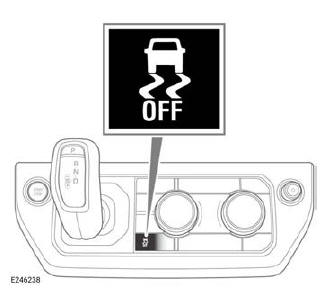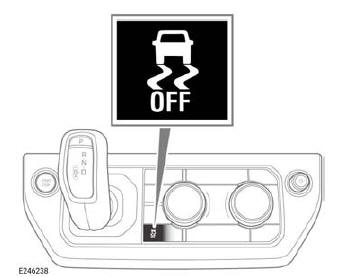Land Rover Defender: Switching dynamic stability control (DSC) off

Make sure the relevant safety warnings have been read and understood before driving the vehicle.

The vehicle's stability and safety may be reduced by inappropriately switching Dynamic Stability Control (DSC) off.
Switching DSC off could result in a loss of control of the vehicle, potentially leading to serious injury or death.

Press and briefly hold the DSC OFF button on the front control panel to switch DSC off.
A tone sounds and the DSC OFF amber warning lamp illuminates.
Note: Switching DSC off reduces the level of traction and stability control intervention. An increase in wheel spin and a reduction in the vehicle's stability may be experienced.
Note: In the majority of driving situations, and particularly on-road, it is recommended that DSC is not switched off.
Note: DSC cannot be switched off if the comfort, ECO or AUTO terrain response driving programs are selected.
Note: Make sure DSC is switched back on at the earliest opportunity.
SWITCHING DYNAMIC STABILITY CONTROL (DSC) ON

Make sure the relevant safety warnings have been read and understood before driving the vehicle.

Press the Dynamic Stability Control (DSC) OFF button on the front control panel to switch DSC on.
The DSC OFF warning lamp extinguishes to confirm DSC has been switched on.
Note: DSC automatically enables when the vehicle's ignition is switched on.
ACTIVE REAR LOCKING DIFFERENTIAL

Make sure the relevant safety warnings have been read and understood before driving the vehicle.
The active rear locking differential improves traction on uneven surfaces.

Make sure the following guidance is followed, to avoid causing damage to the active rear locking differential.
During the vehicle's first 1 000 miles (1 600 km):
- Avoid fully pressing the accelerator pedal.
- Do not exceed a vehicle speed of
more than 120 mph (190 km/h).
Note: Always observe the national speed limits for the country in which the vehicle is traveling.
- Avoid prolonged periods of driving at speeds in excess of 100 mph (160 km/h).
ALL WHEEL DRIVE (AWD)
The All Wheel Drive (AWD) system enhances the vehicle's traction and stability on uneven and slippery roads, and in adverse conditions.
The AWD system automatically varies the status between AWD and Rear Wheel Drive (RWD) to suit the current driving style and prevailing conditions. The status can viewed via the 4x4i feature.
The instrument panel displays a message if a fault is detected with the AWD system.
Reduced vehicle performance may also be experienced. In this event, the vehicle can still be driven, but with extra care. If the fault persists, contact a retailer/ authorized repairer at the earliest opportunity.

